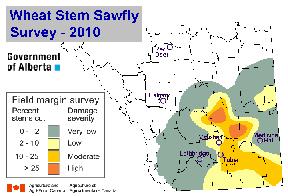| |
2011 Wheat Stem Sawfly Forecast | |
| |
|
|
| |
|
|
| |
| The area at risk of economically significant sawfly populations in 2011 will be similar to slightly higher than last year. The 2010 field margin survey shows low populations in most of the area surveyed including the traditional sawfly areas in the Special Areas. The damage ratings are based on 75 in 14 municipalities. Some areas of southern Alberta still have populations that are high enough to result in significant damage to wheat crops. The highest populations of sawfly were found in Newell, Forty Mile, Taber and Warner counties. There were also hot spots in Cypress County and the M.D of Acadia. |
 |
 | |
The Wheat Stem Sawfly Map is based on cut stem counts conducted after the 2010 harvest. The percent of stems cut by sawfly gives an indication of the number of reproductive adult sawflies that will emerge in late June through early July. Winter conditions have very little impact on sawfly populations and a high proportion of wheat stems cut in the fall will produce adults. Producers in areas with moderate to high levels of cutting should consider using solid stem wheat as a control strategy.
Female sawflies lay eggs inside grass and grassy crop stems; the eggs hatch and tunnel inside stems until near harvest. As the crop starts to ripen the sawfly larva migrates to the stem base and cut a notch most of the way through the stem. Feeding damage from the tunneling can result in hidden yield losses of 10 to 15 percent. Further yield losses can occur from lodging at harvest. For more information about the lifecycle can be found at Wheat Stem Sawfly Life Cycle.
It is possible that population hot spots still exist in areas of lower risk, individual producers need to be aware of the potential risks in their own fields. Cutting levels higher than 10 to 15 percent in the previous crop indicate the need to consider seeding solid stem wheat to reduce sawfly losses. It is important farmers evaluate their individual situations in making their variety choices.
Parasitism can reduce populations and reduce the level of cutting. A parasitic wasp, Bracon cephi, has been shown to have significant impact on sawfly populations. The use of solid stem wheat varieties and the increase in parasitism are the major factors in lower sawfly populations in Alberta.
For more information of sawfly and their management contact the Ag-Info Centre at 310-FARM (3276).
Wheat Stem Sawfly FAQ
Economic thresholds for wheat stem sawfly
Follow this link to print a page size version of the map.
Follow this link to the Agriculture Canada tri-provincial forecast maps. Please go to the drop-down menu to locate the wheat stem sawfly map.
Follow this link to view the 2011 insect forecast video presentation.
|
|
| |
|
|
| |
For more information about the content of this document, contact Scott Meers.
This document is maintained by Shelley Barkley.
This information published to the web on January 14, 2011.
Last Reviewed/Revised on January 21, 2013.
|
|